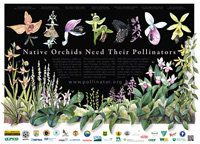THE POLLINATORS
Pollinator Overview
Pollination occurs when pollen is moved within flowers or carried from flower to flower by pollinating. Almost 90% of all flowering plants rely on animal pollinators for fertilization, and about 200,000 species of animals act as pollinators. Of those, 1,000 are hummingbirds, bats, and small mammals such as mice. The rest are insects like beetles, bees, ants, wasps, butterflies and moths. Plants can also be pollinated by wind and water. The transfer of pollen in and between flowers of the same species leads to fertilization, and successful seed and fruit production for plants. Pollination ensures that a plant will produce full-bodied fruit and a full set of viable seeds.
Worldwide, approximately 1,000 plants grown for food, beverages, fibers, spices, and medicines need to be pollinated by animals in order to produce the goods on which we depend. In the United States, pollination by honeybees and other insects produces $40 billion worth of products annually
Learn more about the pollinator lifecycle here and how you can help protect them here!
Pollinator Identification
1. Syrphid fly - Sphaerophoria philanthus |
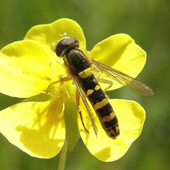
-
Geographic Distribution: From Canada, through California, down to Mexico, and Florida.
-
Habitat: This is a widespread species of heathland, bogs, mire, moorland, heathy woodland rides and coastal dunes - especially in damper areas where Purple Moor-grass, cotton-grasses and rushes are present. Wheat crop and grass fields, forest floor.
-
Size: 7.6-9.6mm.
-
Identification: One pair of iridescent wings and big eyes. Black and yellow stripes with a long thin abdomen that curves slightly under at the end. The abdomen is about 3 times longer than the stout, bulbous thorax. 6 yellow legs with the hind pair much longer than the fore-pairs. Short tongue.
-
Other Plants Commonly Visited: Flowers like Tormentil and Heath Bedstraw.
Flies are among the most frequent visitors to flowers and important pollinators of a wide range of plants. Syrphid flies are often referred to as flower flies. This group exhibits a characteristic flight pattern where they hover and can abruptly change their position. They are called hover flies in Great Britain. Syrphid flies can be easily mistaken for bees and wasps. However, flies have only one pair of wings while bees and wasps have two. Their large eyes, short antenna also give them away. They also have nowhere to carry pollen. Of the nearly 900 species of flower flies (family Syrphidae) in North America, most have yellow-and-black stripes. |
back to the top
2. Owlet moth - Mesogona olivata |
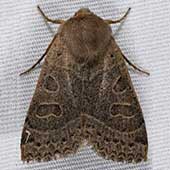
- Geographic Distribution: Occurs from British Columbia to California, Colorado and Texas. Most likely can be found in Northern Mexico.
- Larvae Characteristics: Larval foodplants include a diverse assortment of woody plants such as poplar, oak, hazel, Amelanchier Medic., alder, antelope brush, Symphoricarpos Duhamel and Berberis L.
- Habitat: Wet forest to semi-arid steppe.
- Size: Forewing length 15-20mm and 2xs as long as wide.
- Identification: Most specimens are brownish but reddish morphs can be common. Forewing reddish brown. Hindwing gray, vesica of aedoeagus with two distal bands of short thin cornuti, appendix bursae overlapping corpus bursae ventrally, long “tarsal claws” or first legs.
- Other: Individuals from semi-desert locales tend to be pale while those from more mesic forest are darker. M. olviata is sympatric with both other Mesogona species.
Genotype of Mesogona. Considered to be the “Old World” species of Pseudoglaea (genus). There are five species in this genus, two in Eurasia and three in North America. Until recently only one North American species, olivata Harvey has been described. M. olviata was more recently discovered in observations in Oregon and Washington. Adult moths are most active and lay their eggs in the fall when foliage is changing color. The larvae hatch in the spring feeding on a variety of woody plants. Moth coloring often resembles the bark of the foodplant it prefers. This is most likely a protective adaptation.
|
back to the top
3. American bumblebee - Bombus pensylvanicus |
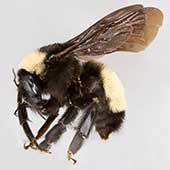
- Geographic Distribution: Eastern North America, from Quebec to Florida west to Colorado, Texas.
- Nest Characteristics: Nests on ground surface.
- Habitat: Large fields.
- Size: Large, Queen 21-25mm, Worker 14-18mm, Male 16-22mm.
- Identification: Female’s top of the head black, thorax with yellow band(s), T1 often yellow especially in the middle, T2-3 yellow, tail black, face long. Midleg basitarsus with the distal posterior corner sharply narrowly produced and spinose, hind basitarsus with the proximal posterior process long and pointed (longer than broad). Cheek slightly longer than broad, clypeus with large punctures except on the mid line. Hair on the top of the head always black, T1 with yellow hairs more frequent medially. Hair short and even. Males have a yellow abdomen with a black head and black striping in the lower thorax.
- Other Plants Commonly Visited: Vetches, clovers, goldenrods, St. John’s wort, boneset.
- Other: Uncommon, possibly in decline. Parasitized by B. variabilis.
There was a time you could find this bumblebee across most of North America from Quebec to Florida, westward to South Dakota then south into the central Mountains of Mexico. Within the past decade, though, its numbers have collapsed and it is strongly suspected it was infected with a virus when European bumblebees were imported into North America to pollinate greenhouse tomatoes. In spring the overwintering queens of our American bumblebee pollinate many spring wildflowers. It’s fun to watch these plump ladies hang upside down while they forage on the nodding flowers of trout lilies (Erythronium) or columbines (Aquilegia). Of course, they are collecting nectar and pollen to feed to their first brood of workers. Once the workers mature the queen stays home and her daughters pollinate the wildflowers and bushes of summer and autumn. Like most bumblebees in Canada and America the colony is annual. The queen dies in the autumn cold weeks after she produced new queens in late summer or early fall.
|
back to the top
4. Mosquito - Aedes communis |

-
Geographic Distribution: True snowpool species that is most common in the northern U.S. and Canada to Alaska. Most commonly found in New Jersey.
-
Larvae Characteristics: Larvae are present in late March and most often begin pupating during the 3rd week of April. Larvae are most common in deep snowpools filled with dark colored water in forested areas above elevations of 1500 ft. Usually the only large species mosquito present in a given pool.
-
Habitat: Heavily forested areas at high elevations.
-
Size: Large.
-
Identification: Upper and lower head hairs are usually single, occasionally double. Antenna length is shorter than head and the tuft is inserted before the middle of the shaft. Long pointed gills frequently have a rusty color. Patched comb scales. Pecten is evenly spaced. In the anal segment the saddle is incomplete and with 2-4 precratal tufts.
-
Other: Ades communis is a major pest in the Adirondacks in New York State and the Pocono Mountain range in Pennsylvania. It is one of the earliest mosquitoes to appear in the northeast monocyclic species.Sacks
of pollen or pollinium can be seen carried by mosquitos after visiting
pollen rich flowers. See yellow pollinium in the photo above.
We all know that female mosquitos bite and drink blood to provision the next generation of eggs but where do they get the energy to pester us? Some consume the sugars in flower nectar to fuel their attacks on us. Here in North America, at least 15 species in the genus Aedes are known to drink the nectar of small-flowered, greenish orchids placed in the genus Platanthera. A paper suggesting that they also pollinated the orchid appeared in 1913. There’s no doubt now that, this insect has mouthparts long enough to reach the nectar in the orchid’s little spur. As she prepares to leave her the flower her head touches the sexual organs in the flower’s column and two golden “eggs” of pollen (pollinia) are deposited on her face because the eggs come complete with their own little stalks and sticky suction cups. Cross-pollination occurs when she visits a second flower on a second plant. Of the 15 species, Aedes communis is the best studied as it is so common on summer tundras and bogs where these little orchids may thrive. The great American authority on native orchids, Carlyle Luer, described how they hummed in swarms around the blunt leaf orchid carrying so many bright yellow balls of pollen the insects looked like they were wearing their own head lamps. Therefore, while this mosquito may be a bit…annoying...it should not be confused with its bad cousin, A. egypti, known to transmit yellow and dengue fevers.
|
back to the top
5. Pipevine swallowtail - Battus philenor |
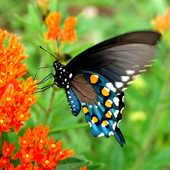
- Geographic Distribution: Southern half of the U.S. to southern Mexico.
- Larvae/Egg/Chrysalis Characteristics: The eggs are red-orange and circular. The caterpillars are black with red projections and spots running down their backs. These colors can be affected by temperature with warmer climates resulting in shades from black to red. The chrysalis’s posterior end is segmented and has an inward curve. The ventral thorax is raised and the head has a pair of horns at the anterior dorsal portion.
- Habitat: Mostly warm climates in open woodlands, meadows.
- Size: Wing span 2 ¾ - 5 in.
- Identification: Fore-wing of adults is black above and gray below. The dorsal hind-wing is where sexual dimorphism is obvious. Males have smaller cream or pale spots than females, and the spots run along the fringe of the wings. Males are brighter metallic blue in the dorsal hind wing region. Bottom half of the ventral hind wing of both sexes is metallic blue. A single row of seven orange spots and small pale, cream dots are found at the edge of the wing embedded in the blue section.
- Other Plants Commonly Visited: Thisles, bergamot, lilac, viper’s bugloss, common azaleas, phloc, teasel, dame’s rocket, lantana, petunias, verbenas, lupines, yellow star thistle, California buckeye, yerba santa, broiaceas and hilias.
- Other: Females lay clusters of eggs on or under pipevine leaves, usually exposed to the sun. Pipevine leaves are actually toxic to many other animals, this helps protect the caterpillars.
It’s easy to confuse this striking butterfly with the black swallowtail (Papilo polyxen)as both species have dark forewings and you can find some black swallowtails that also wear iridescent blue on their hind wings. The black swallowtail comes into our gardens to lay eggs on carrots, dill, parsley and other members of the celery family. In contrast, the caterpillars of our pipevines eat only the leaves of birthworts and dutchman’s pipes (Aristolochia). If you want to lure these butterflies into your garden you should provide them with birthwort vines available from native plant nurseries and seed companies. These woody vines are rather primitive and related to magnolias but native, American birthworts are pretty easy to grow if you have some dappled shade and add humus to your soil.
|
back to the top
6. Miner bee - Anthophora abrupta |
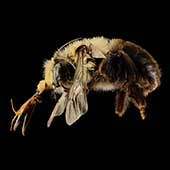
- Geographic Distribution: From Texas to the east coast of the U.S., from Florida to Canada.
- Nest Characteristics: Solitary, ground nesting bee. Females dig a tunnel, often in clay. Nests are clustered together but females only provide for their own nest and future offspring.
- Habitat: Well-drained soils to nest in such as banks, hills and road cut-outs
- Size: The adult female A. abrupta are 14.5–17 mm long and the adult male A. abrupta are 12–17 mm long.
- Identification: The head, legs and abdomen are lightly covered in brown-black hairs while the thorax is covered in dense, pale yellow-orange hairs. The wings are nearly transparent to slightly cloudy with brown-black veins. The males have a distinctive set of hairs on the margin of their yellow clypeus, like a mustache. The males carry pheromones attractive to females in their mustaches. The female’s cheeks are approximately the same width as their eyes and they have a strongly protuberant clypeus (the area on the center of the face between the eyes and mouth).
- Other Plants Commonly Visited: A. abrupta has been recorded to visit many flowers and is considered a forage-plant generalist that will nest in the same location for many years.
- Other: Non-aggressive bees and do not typically sting.
This chunky, furry bee is smaller than a honeybee but very important to flower pollination in the mid-west. It visits a wide range of wildflowers native to our woodlands and prairies. As females don’t feed males the male bee must gather his own nectar and is also an important pollinator. This includes his visits to the rare, Mead’s milkweed (Asclepias meadii). The Cypripedium reginae does not give the bee any reward and traps it temporarily in its sac. Anthophora abrupta are potential pollinators of many important crops including: cranberry, tomato, blackberry, asparagus, persimmon, clover and raspberry.
|
back to the top
7. Orchid bee - Eulaema meriana |
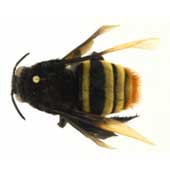
- Geographic Distribution: New world tropics.
- Nest Characteristics: Ranging from small single-female nests to large nests with more than one female and a possible division of labor. Mud is the preferred building material with a little resin from wounded trees. Each female constructs 8 brood cells rearing her larvae on the pollen and nectar of many tropical trees, bushes and orchids.
- Habitat: Tropics.
- Size: Large.
- Identification: Big, hairy and velvety with exceptionally long tongues. Black head and thorax with black and yellow striped abdomen. Hair coloration at the back end, around the stinger burnt orange. Wings are yellow translucent with veins.
- Other: Male bees collect fragrance from plants to attract females, in turn pollinating them.
There are about 25 species in the genus Eulaema through the New World tropics. They are big, hairy and velvety insects unlike their smaller, shiny, metallic cousins, the blue and gold and violet colored orchid bees (Euglossa species). Two to four pregnant females of Eulaema meriana share the same nest but do not really cooperate with each other. They come to collect the spicy perfumes of the flower. A male E. meriana needs to make his own personal cologne to complete his life-cycle. Therefore, if a male of E. meriana visits a vanilla flower it may not be looking for nectar at all but something to add to its cache of perfume. Male bees are territorial and have a specific perch where they will wait for an attracted female. |
|
|
